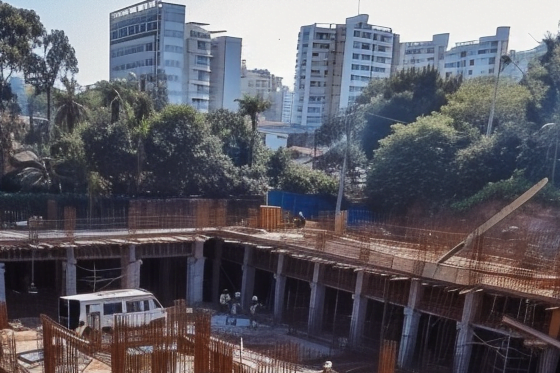Critical Path Method (CPM) is a key tool in construction management for planning, scheduling, and overseeing projects with complex timelines and task dependencies. Developed in the 1950s by DuPont and Remington Rand, CPM helps identify the longest sequence of tasks (the critical path) that determines the minimum project duration, allowing project managers to focus on activities that directly impact completion. This blog will explore CPM principles, its application in construction, real-world examples, and insights from relevant data to provide a thorough understanding of this essential project management technique.
The Critical Path Method (CPM)
It is a foundational project management technique used to pinpoint the longest sequence of dependent tasks and calculate the shortest time in which a project can be completed. It is essential for identifying critical tasks that, if delayed, would extend the project’s overall timeline. The Critical Path Method relies on detailed network diagrams that map out tasks, their durations, and dependencies, providing project managers with a visual framework to analyze workflows comprehensively. By focusing on critical tasks susceptible to delays, the Critical Path Method enables managers to streamline project timelines effectively, ensuring efficient resource allocation and timely project delivery in complex project environments like construction, management.

Key Components of the Critical Path Method
Tasks (Activities): Tasks are the specific actions required to complete a project. They should be clearly defined and manageable to ensure smooth progression. For example, in construction, tasks might include site preparation, laying foundations, and installing windows. Proper task management helps allocate resources, estimate costs, and maintain project scope.

- Duration: Duration is the estimated time to complete each task. Accurate estimation considers the task’s complexity, resource availability, and potential risks. For instance, software development tasks may be estimated based on past experiences. Correctly estimating durations ensures a realistic project timeline and budget.
- Dependencies: Dependencies define the order in which tasks must be performed, such as one task needing to finish before another starts (finish-to-start). Recognizing dependencies helps avoid bottlenecks. For example, window installation depends on the completion of building framing in construction projects.
- Critical Path: The critical path is the longest sequence of dependent tasks that determines the minimum project duration. Delays in critical path tasks directly impact the project’s completion date. Identifying this path helps prioritize tasks and allocate resources effectively to stay on schedule.
- Float (Slack): Float, or slack, is the time a task can be delayed without affecting the project’s overall timeline. Understanding float allows flexibility in scheduling and helps manage unexpected delays. For example, a task with 3 days of float can be postponed without impacting the project deadline.
How Critical Path Method Works
Step-by-Step Implementation

- Identify Tasks: List all activities required to complete the project. Tasks should be specific and clearly defined. For example, in construction, tasks might include site preparation, excavation, and electrical work. Proper task identification helps in developing a comprehensive project plan.
- Estimate Durations: Determine how long each task will take to complete. Consider factors like task complexity, resources needed, and potential risks. Techniques such as expert judgment and historical data analysis can help in providing accurate estimates, ensuring a realistic project timeline.
- Establish Dependencies: Define the relationships between tasks to determine their sequence. Dependencies like finish-to-start or start-to-start dictate the order tasks must follow. Recognizing these helps prevent bottlenecks and ensures a smooth workflow throughout the project.
- Construct Network Diagram: Create a visual representation of the project schedule, showing tasks, durations, and dependencies. Tools like Microsoft Project or Primavera can help create this diagram, which is useful for identifying the critical path and visualizing task flow.
- Calculate Early Start (ES) and Early Finish (EF) Times: Determine the earliest possible start and finish times for each task based on their dependencies. Calculating ES and EF provides insight into the earliest timeline for project completion and helps in scheduling tasks efficiently.
- Calculate Late Start (LS) and Late Finish (LF) Times: Calculate the latest start and finish times a task can have without delaying the project. These times help identify tasks with float, allowing for flexibility in scheduling and helping manage potential delays.
- Identify Critical Path: The critical path is the longest sequence of tasks that determines the minimum project duration. Tasks on this path have zero float, meaning any delay will directly affect the project’s completion date. Identifying the critical path is key for prioritizing and resource allocation.
- Monitor and Update: Continuously monitor task progress and update the CPM diagram to reflect actual progress. Regular updates help identify delays or changes needed to keep the project on schedule, ensuring successful project delivery.
Application of Critical Path Method (CPM) in Construction Management

1. Project Planning and Scheduling
Critical Path Method plays a crucial role in construction project planning and scheduling by providing a structured approach to organizing tasks and timelines. Here’s how it enhances these processes:
- Detailed Project Schedules: Critical Path Method enables construction managers to create detailed schedules that outline the sequence of tasks, their durations, and dependencies. This level of detail allows for better planning and coordination among various stakeholders, including subcontractors and suppliers.
- Sequence of Tasks: By identifying the critical path— the longest sequence of dependent tasks—Critcal Path Method helps in determining the order in which tasks must be executed to minimize project duration. For instance, tasks like foundation work typically depend on earlier tasks, such as site preparation, being completed first.
- Resource Allocation: With a clear understanding of task dependencies and durations, construction managers can effectively allocate resources such as manpower, materials, and equipment. This allocation is critical for ensuring that resources are available when needed, thereby avoiding delays and optimizing project efficiency.
- Coordination of Subcontractors: Critical Path method facilitates coordination among subcontractors by providing them with a predictable timeline and sequence of work. Subcontractors can plan their activities accordingly, reducing conflicts and potential delays.
2. Resource Allocation and Management
Efficient resource allocation is essential for keeping construction projects on schedule and within budget. Critical Path Method aids in resource management through:
- Prioritization based on Critical Path: By identifying the critical path, construction managers can prioritize resources for tasks that directly impact project timelines. Tasks on the critical path have zero float, meaning any delay in these tasks will delay the overall project completion.
- Optimization of Resources: With a detailed project schedule in place, managers can optimize the allocation of resources such as labor, materials, and equipment. This optimization minimizes idle time and ensures that resources are utilized efficiently throughout the project lifecycle.
- Resource Contingency Planning: Critical Path Method also helps in developing contingency plans for resource allocation. For example, if a critical task requires additional manpower or specialized equipment, managers can plan ahead to ensure these resources are available without disrupting the project timeline.
3. Risk Management
Risk management is crucial in construction projects, where uncertainties and unexpected events can impact timelines and costs. Critical Path Method aids in risk management by:
- Identification of Critical Tasks: Critical tasks identified through Critical Path Method are those that, if delayed, would extend the project duration. By focusing on these tasks, managers can prioritize risk assessment and mitigation efforts.
- Contingency Planning: With insights from CPM, construction managers can develop contingency plans to address potential risks associated with critical tasks. These plans may involve alternative approaches, resource reallocation, or preemptive actions to mitigate risks before they escalate.
- Scenario Analysis: CPM allows for scenario analysis, where managers can simulate the impact of different risks on the project schedule. This proactive approach helps in devising effective risk response strategies and maintaining project resilience.
4. Progress Tracking and Control
Critcal Path Method provides a structured framework for monitoring project progress and maintaining control over project timelines. Key aspects include:
- Real-Time Monitoring: Construction managers use CPM to track actual progress against the planned schedule in real-time. This monitoring helps in identifying deviations, delays, or potential bottlenecks early on.
- Comparison with Baseline Schedule: By comparing actual progress with the baseline CPM schedule, managers can assess project performance and identify areas where corrective actions are needed. This comparison enables proactive decision-making to keep the project on track.
- Issue Resolution: CPM facilitates timely issue resolution by highlighting tasks that are behind schedule or at risk of delay. Managers can allocate resources, adjust priorities, or implement corrective measures to address issues promptly and prevent further disruptions.
- Communication and Reporting: CPM enhances communication among project stakeholders by providing a clear and visual representation of project timelines. Regular progress reports based on CPM analysis ensure that all stakeholders are informed about project status and any adjustments to the schedule.
Benefits of Using Critical Path Method in Construction Management
Enhanced Project Planning
Critical Path Method provides construction managers with a structured approach to project planning, ensuring that tasks are sequenced optimally for efficient execution. Benefits include:
- Detailed Roadmap: CPM creates a detailed roadmap of tasks and timelines, facilitating better planning and coordination among stakeholders.
- Optimized Sequencing: By identifying the critical path, managers can sequence tasks to minimize project duration and optimize resource utilization.
- Improved Coordination: CPM enhances coordination of subcontractors and suppliers by providing a clear timeline and sequence of work.

Improved Resource Management
Efficient resource management is crucial for controlling costs and ensuring timely project delivery. Critical Path Method supports resource management by:
- Prioritizing Critical Tasks: Managers prioritize resources for critical path tasks to minimize delays and maintain project momentum.
- Optimizing Resource Allocation: With a clear schedule, managers can allocate resources such as labor and materials efficiently throughout the project lifecycle.
- Contingency Planning: CPM enables proactive contingency planning for resource allocation, ensuring that resources are available when needed to address unforeseen challenges.
Effective Risk Management
Risk management is integral to mitigating project uncertainties and minimizing disruptions. Critical Path Method aids in risk management by:
- Identifying Critical Risks: Managers identify risks associated with critical path tasks and develop mitigation strategies to prevent delays.
- Scenario Planning: CPM allows for scenario analysis to assess the impact of risks on project schedules, enabling proactive risk response planning.
- Enhanced Decision-Making: By integrating risk analysis into project planning, managers make informed decisions to maintain project timelines and mitigate potential setbacks.
Accurate Progress Tracking
Monitoring project progress is essential for identifying issues early and implementing timely corrective actions. Critcal Path Method facilitates progress tracking by:
- Real-Time Monitoring: Managers track actual progress against the CPM schedule in real-time, enabling early detection of deviations or delays.
- Baseline Comparison: Comparing actual progress with the baseline schedule helps in evaluating project performance and adjusting plans as necessary.
- Issue Resolution: CPM supports timely issue resolution by highlighting tasks that are behind schedule or at risk, allowing managers to allocate resources and address issues promptly.
Data-Driven Insights and Trends
Integration with Building Information Modeling (BIM)
The integration of Critical Path Method with Building Information Modeling (BIM) enhances project visualization and coordination. Benefits include:
- 3D Project Visualization: BIM provides a 3D digital model of the project, complementing the 2D CPM schedule with visual insights into project components and sequencing.
- Collaboration and Communication: BIM-CMP integration improves collaboration among stakeholders by visualizing project timelines and dependencies in a comprehensive format.
- Enhanced Coordination: Stakeholders can better coordinate activities based on both the temporal sequencing from CPM and spatial information from BIM, reducing conflicts and improving project efficiency.
Use of Advanced Technologies
Technological advancements are transforming Critcal Path Method in construction management, enhancing efficiency and decision-making. Examples include:
- Artificial Intelligence (AI): AI algorithms analyze project data to predict risks, optimize schedules, and recommend resource allocations, enhancing project planning and execution.
- Drones: Drones provide aerial surveys and real-time monitoring of construction sites, offering valuable data for CPM analysis and progress tracking.
- Real-Time Data Analytics: Analytics tools provide insights into project performance metrics, enabling managers to make data-driven decisions and adapt plans dynamically.
Sustainability and Green Building
Critical Path Method is increasingly applied to manage green building projects, integrating sustainability practices into project schedules. Benefits include:
- Green Materials Integration: CPM schedules incorporate tasks for sourcing and implementing sustainable materials, aligning project timelines with environmental goals.
- Efficiency Improvements: By optimizing task sequencing and resource allocation, CPM supports efficient use of sustainable practices and materials, minimizing environmental impact.
- Compliance and Certification: CPM ensures that tasks related to obtaining green building certifications are integrated into project schedules, facilitating compliance with environmental standards.

Conclusion
The Critical Path Method (CPM) is an indispensable tool in construction management, providing a systematic approach to project planning, scheduling, and control. By identifying the critical path and focusing on essential tasks, construction managers can optimize resources, manage risks effectively, and ensure project success. The integration of advanced technologies and data-driven insights further enhances the effectiveness of Critcal Path Method , enabling managers to make informed decisions and adapt to evolving project dynamics.
As the construction industry continues to evolve, the importance of Critcal Path Method in managing complex projects and achieving operational efficiency cannot be overstated. By leveraging CPM and embracing innovative technologies, construction managers can navigate challenges, minimize risks, and deliver projects on time and within budget.
FAQs
What is critical path method in construction management?
It is a scheduling technique that maps activities, durations, and dependencies to identify the longest chain of tasks that determines the earliest possible project completion date.
Does Cpm Work For Small Projects?
Yes. even a short list of activities with clear predecessors can reveal the true bottleneck and help avoid last-minute rushes.






